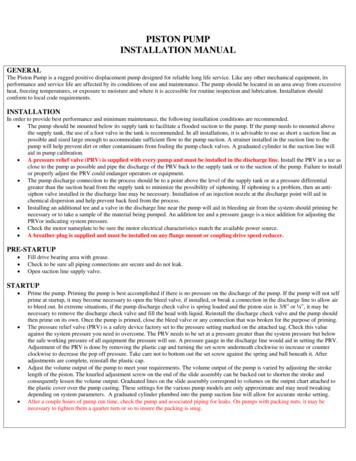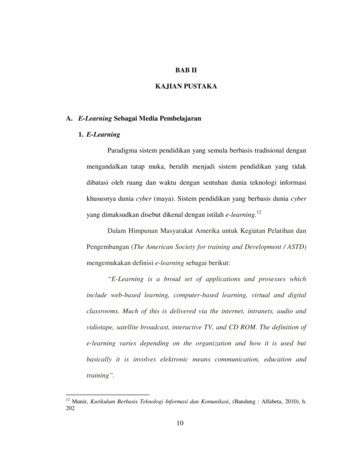Millikan Oil Drop - De Anza College
MILLIKAN OIL DROP EXPERIMENTINTRODUCTIONIn this experiment you will experimentally determine the quantum nature of charge.Robert Millikan was awarded the Nobel Prize in physics in 1923 for this brilliantexperiment. A simplistic schematic of his apparatus is shown below.A spherical drop of oil, falling through a viscous medium like air, will quickly reach aconstant velocity. When it reaches this equilibrium state, the viscous force is balanced byother forces acting on the drop, such as gravity, buoyant forces from the air, electricalforces, etc. In this experiment an electrical force of varying magnitude is introduced tochange the motion of the falling drop by an ionization source. By measuring the velocityof the oil drop under different conditions the amount of charge on the drop may bedetermined. If the charge on the drop is an integer multiple of the fundamental unit ofcharge (the electron), then one will be able to confirm the quantization of charge.EQUIPMENT1.2.3.4.5.6.7.Millikan Oil Drop Apparatus (see diagrams below)High voltage power supply (0-500VDC)Digital multimeter4 banana leadsStopwatchMicrometerBarometer1
Millikan Oil Drop Apparatus2
THEORYThe charge carried by an oil droplet can be obtained by analyzing the forces acting on thedrop under different conditions. Figure 1 shows the forces acting on the drop when it isfalling in air and has reached its terminal velocity.kvfvelocitydownwardmgFigure 1In this experiment the terminal velocity of the drops is reached in a few milliseconds.Applying Newton’s 2nd Law to the falling oil drop yields:kvf - mg 0(E-field off)(1)Figure 2 shows the forces acting on the drop when it is rising under the influence of anelectric field. velocityupwardqnEmgkvrFigure 23
Applying Newton’s 2nd Law again we have:qnE - mg - kvr 0(E-field on)(2)In Equations (1) and (2) we have neglected the buoyant force exerted by the air on thedroplet. This is reasonable since the density of air is only about one-thousandth that ofoil. The equations can now be used to obtain an expression for the charge qn on the oildrop. The result is:qn mg (v f v r )vf E(3)The electric field in the region of the oil drop is produced by to two parallel platesmaintained at a potential difference V and separated by a distance d. The relation is givenby E V/d. Thus, equation (3) becomes:qn mgd (v f v r )vfV(4)The mass ‘m’of the oil drop is given by:m (4/3)πa3σ(4)where ‘a’ is the radius of the drop and ‘σ’ is the density of the oil drop.To calculate the radius of the oil drop you will need to use Stokes’ Law, which relates theradius of a spherical falling body in a viscous medium to its terminal velocity. Accordingto Stokes’ Law the viscous force on a spherical falling body in a viscous medium is givenby:F 6πηavf(5)where η is the coefficient of viscosity, which in our case will be the viscosity of air.Using this expression and applying Newton’s 2nd Law to a falling oil drop under theinfluence of the viscous and buoyant force, one can show that the radius of the oil drop is:4
a 9ηv f(6)2 g (σ ρ )Where σ is the oil drop density, ρ is the density of air, vf is the falling velocity, g is theacceleration of gravity, and η is the coefficient of viscosity air. Here we have includedthe density of air for better accuracy.Stoke’s Law becomes incorrect when the velocity of fall of the droplets is less than 0.1cm/s. Droplets having this and smaller velocities have radii, on the order of 2 µm,comparable to the mean free path of air molecules, a condition which violates one of theassumptions made in deriving Stoke’s Law. Since the velocities of the droplets used inthis experiment will be in the range of 0.01 to 0.001 cm/s, a correction factor must beincluded in the expression for en. This factor is: 1 1 b / pa 3/ 2(7)where b is a constant, p is the atmospheric pressure, and a is the radius of the drop u should also measure the temperature at the end of the lab to make youare recording the correct temperature.EXPERIMENTAL PROCEDURE1. Complete the reassembly of the droplet viewing chamber by placing the droplet holecover on the top capacitor plate and then placing the lid on the housing (see figure 3).2. Measure and record the plate voltage and the thermistor resistance (temperature).8
Introducing the droplets into the chamber1. Put non-volatile oil of known density into the atomizer.2. Prepare the atomizer by rapidly squeezing the bulb onto a paper towel until oil isspraying out.3. Make sure the tip of the atomizer is pointing down.4. Move the ionization source lever to the Spray Droplet Position to allow air to escapefrom the chamber during introduction of droplets into the chamber.5. Place the tip of the atomizer into the hole on the lid of the droplet-viewing chamber.6. While observing through the viewing scope, squeeze the atomizer bulb with onequick squeeze. Then squeeze it slowly to force the droplets through the hole in thedroplet hole cover, through the droplet entry hole in the top capacitor plate, and intothe space between the two capacitor plates.7. When you see a shower of drops through the viewing scope, move the source lever tothe OFF position.Selection of the Drop1. From the drops in view, select a droplet that falls slowly (about 0.02 - 0.005 mm/s)when the plate charging switch is in the “Plates Grounded” position (no E-field) andhas at least one negative charge (changes direction when plates are charged). Thedistance between major reticle lines is 0.5 mm.Hint: A drop that requires about 15 s to fall the distance between the major reticlelines will approximately rise the same distance, under the influence of an electric field(1000V/cm), in the following times with the following charges: 15s -1 excesselectron; 7s - 2 excess electron; 3s - 3 excess electron.2. When you find an appropriately sized and charged oil droplet, fine-tune the focus ofthe viewing scope. The oil droplet is in best focus for accurate data collection when itappears as a pinpoint of bright light.Measuring the Rise and Fall Times of the Oil Droplet1. Measure the rise (plates charged) and fall (plates not charged) velocities of theselected droplet 10 times. Maneuver the droplet as needed using the plate voltageswitch.Hint: The greatest accuracy of measurement is achieved if you time from the instantthe oil drop passes behind the first major reticle line, to the instant the drop passesbehind the second major reticle line. (These lines are 0.5 mm apart)2. Calculate the charge on the droplet. If the result yields that the charge on the dropletis greater than 5 excess electrons, you should repeat the procedure for slower movingdroplets.3. Repeat steps (1) and (2) for one additional different drop.9
ANALYSIS1. Prove that the radius of the oil drop is given by equation (6):a 9ηv f2 g (σ ρ )2. Make a data table with the fall and rise distances and times for each oil droplet.3. Label and show calculations for:a) (vr)average average rise velocityb) (vf)average average fall velocityc) ρ density of aird) a radius of drope) m mass of drop3/ 2f)g) 1 correction factor 1 b / pa qn charge on oil drop4. Include a table like the following in your report:drop123dσρgηbpavr(ave)vf(ave)Vm5. Using the accepted value for the charge on an electron, calculate the number ofelectrons in each oil drop.6. Comment on sources or errors involved in the experiment.7. Did this experiment prove the quantization of charge? Explain.10qn
11
Appendix C: Density of Airρ ρoP 273.16, where ρ o density of air at 0oC, 1 ATM 1.2929 kg/m3760 T12
The mass ‘m’of the oil drop is given by: m (4/3)πa3σ (4) where ‘a’ is the radius of the drop and ‘σ’ is the density of the oil drop. To calculate the radius of the oil drop you will need to use Stokes’ Law, which relates the radius of a spherical falling body in a viscous medium to its terminal velocity. According
1.Engine Oil SABA 13 1.Engine Oil 8000 14 1.Engine Oil 6000 15 1.Engine Oil 3000 16 1.Engine Oil Alvand 17 1.Engine Oil Motor Cycle Engine Oil M-150 18 1.Engine Oil M-100 19 1.Engine Oil Gas Engine Oil CNG-BUS 20 1.Engine Oil G.I.C.X.LA 21 1.Engine Oil G.I.C.X. 22 1.Engine Oil Diesel Engine Oil Power 23 1.Engine Oil Top Engine 24
V-5 and V-10 pumps are shipped from the factory with the speed reducer filled with the proper amount . Amoco Oil Co. Worm Gear Oil Cylinder Oil #680 . Shell Oil Co. Valvata Oil J460 Valvata Oil J680 Sun Oil Co. Gear Oil 7C Gear Oil 8C Texaco Honor Cylinder Oil 650T Cylinder Oil Union Oil
Chevron-Turban GST Oil 46. Amoco-Amokon Oil 46. Conoco-Turban Oil 46. Shell-Turbo Oil T-46. Texaco-Regal R & O Oil 46. Exxon- Teresstic Oil 46 32 - 100º F - Viscosity 300 to 350 SUS at 100º F. Grade ISO Approved listing: Chevron-Turban GST Oil 68. Amoco-Amokon Oil 68. Conoco-Turban Oil 68. Shell-Turbo Oil T-68. Texaco-Regal R & O Oil 68.
2 DR. GUNDRY'S SHOPPING LIST ES LST Oils algae oil (Thrive culinary brand) avocado oil black seed oil canola oil (non-GMO, organic only!) coconut oil cod liver oil (the lemon and orange flavors have no fish taste) macadamia oil MCT oil olive oil (extra virgin) perilla oil pistachio oil red .
Angeles for a one-day workshop exploring innovative methods for historic interpretation along the Juan Bautista de Anza National Historic Trail. The late 1700s saw families, soldiers, and priests from present-day Mexico push into the Native homelands of Alta California. Our country’s Spanish colon
Anza Trail volunteers for exemplifying the spirit and theme of Western heritage. For this, the color guard’s first public event, William Islas depicted Lt. Col. Juan Bautista de Anza, leading a contingent of Spanish colonial soldiers and set-tlers through the streets of Tucson. Islas traces his family lin
Anza-Borrego Desert State Park The Volunteer Potluck will be held at 6 p.m. Tuesday, April 16, at the home of Susan Gilliland, 1430 De Anza Drive; it is the last house on De Anza, just before Catarina and it has a citrus grove
Asam folat dapat diperoleh dari daging, sayuran berwarna hijau, dan susu. Gizi buruk (malnutrisi) merupakan penyebab utamanya. Anemia jenis ini jugaberkaitan dengan pengerutan hati (sirosis). Sirosis hati menyebabkan cadangan asam folat di dalamnya menjadi sedikit sekali. Kekurangan asam folat juga dapat menyebabkan gangguan kepribadian dan hilangnya daya ingat. Gejala-gejalanya hampir sama .























